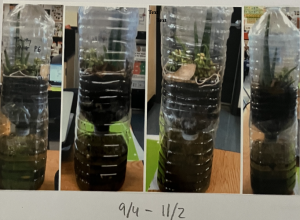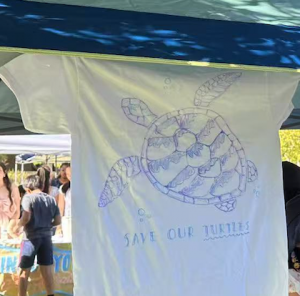By Sriram U (10 Grade); Sep 2024

Image generated using ChatGPT
Ever wondered what it feels like to stand before a panel of judges, explaining your scientific research?
It is an exhilarating experience that I had the privilege of undergoing a couple of times throughout my schooling years. Earlier this year, in March, my friend and I presented our research in the 2024 Synopsys Silicon Valley Science and Technology Championship at the San Jose McEnery Convention Center. We designed and constructed a fire mitigation device to suppress wildfires. My first Science Fair experience was in 1st grade where I demonstrated the phenomenon of solar and lunar eclipse. In 2nd grade, I demonstrated how soil type affects plant growth. And, in 4th grade, I created a hydraulic crane .
I was initially intimidated by the prospect of competing against high school seniors and seasoned science enthusiasts. But with the right mindset and a structured approach, I discovered that science fair can be a truly rewarding journey.
The Mindset Matters
The key to success in a science fair is not just about having a brilliant idea or a snazzy demonstration or presentation; it is about approaching the project with curiosity, perseverance, and a growth mindset.
Embrace challenges as opportunities to learn and grow. Remember, the goal is not to win a prize; it is to explore your passion for science and develop critical thinking skills.

Image generated using Google Gemini
A Step-by-Step Guide to Science Fair Success
❖ Choose a Topic You Are Passionate About – The best science fair projects are driven by genuine interest. Think about what fascinates you and explore related scientific concepts.
➢ [From my experience] Do not choose a topic that is too broad or narrow. It is very important to manage the scope of your project to fit within the timeframe. Depending on your topic, you may have to narrow down a broad topic or expand on a narrow one to achieve desired outcomes within a specific time.
➢ Do not feel pressured to choose a topic that is cool, complex or novel just because it sounds impressive. The most important thing is to pick a topic that genuinely interests you and that you can investigate thoroughly. It is better to choose a simpler topic that you can explore in depth than to tackle a complex one that you cannot fully understand or address. I notice this often in elementary school science fair projects.
❖ Conduct Thorough Research – Gather information from books, articles, and online resources. Talk to experts in the field to gain deeper insights.
➢ [From my experience] Conduct in-depth research using reputable sources and consult with experts in the field. For instance, when we did the Fire Mitigation Device project, we visited local fire stations in our area and interviewed fire fighters, discussed our project, and gathered their inputs on the design at various stages. What you should avoid is relying solely on superficial information which can lead to inaccurate results and/or conclusions.
❖ Develop a Hypothesis – Hypothesis is the question your project aims to answer. Based on your research, formulate a testable hypothesis. A well-formulated hypothesis is essential for a successful project. It provides a clear direction for your experimentation, and it helps you to focus on the most important aspects of your project.
➢ Begin by asking yourself a question about the topic you are interested in. Use an “If….Then….” statement to help you clearly state your hypothesis in a testable way.
➢ An important point to note here is that hypotheses can be negative statements. A negative hypothesis often states that there will be no difference or no correlation between two variables. This can just be as valuable as a positive hypothesis, as it can help to disprove existing theories or establish new ones. For example, the placebo phenomena in medical trials is a critical factor in medical research. Another significant example that comes to mind here is the once widely accepted geocentric model of our solar system which placed Earth at the center. However, Copernicus proposed the heliocentric model, which placed the Sun at the center. This was a negative hypothesis as it rejected the prevailing belief and initially met with severe resistance and skepticism.
➢ And, this brings me to another important mindset/prejudice/stereotype around failure. Failure is a natural part of the learning process. It is not a reflection of your worth; it is simply a step in the journey towards success. Do not let failure discourage you, scare you, or hinder your ability to try new things (experiment).
❖ Design an Experiment – Create a detailed plan outlining the steps you will take to test your hypothesis. Consider variables, controls, and data collection methods. ➢ [From my experience] Ensure your experiment has a clear control group, well-defined variables, and a sufficient number of trials. Depending on the scope of your project, you may want to take a phased approach for the experiment.
❖ Gather Materials – Collect the necessary materials and equipment for your experiment.
❖ Conduct the Experiment – Carefully follow your experimental plan, recording your observations and data. Safety and precautions.
➢ [From my experience] Perseverance is key. Develop a growth mindset and view setbacks as opportunities to learn and improve.
��Did you know that Thomas Alva Edison, famous for inventing the light bulb, had over 1,000 unsuccessful attempts before achieving groundbreaking success? Edison’s perseverance and belief in his abilities allowed him to overcome the challenges and ultimately revolutionize the way we illuminate our world.
❖ Analyze Your Data – Use graphs, charts, or statistical analysis to interpret your findings.
➢ [From my experience] Data can make or break your experiment. Use precise measurement tools to collect data, and record it thoroughly and carefully. Inaccurate or incomplete data can skew your results; and can delay or invalidate your experiment.
➢ Equal significance and attention must be given to data analysis as well. Use appropriate statistical methods and visualizations to present your findings clearly. Failing to analyze your data effectively can hinder your ability to draw meaningful conclusions.
❖ Draw Conclusions – Determine whether your hypothesis was supported or refuted by your data. Remember failures are okay. Learn from your failures.
➢ [From my experience] Ensure your conclusions are directly related to your hypothesis and are based on the evidence you have collected (i.e. data-driven).

❖ Practice Your Presentation – Rehearse your presentation to ensure you can explain your project confidently and clearly.
➢ [From my experience] It is not a Science Fair if you do not have a display board! Create a visually appealing layout with clear labeling and high-quality visuals for your display board. If you are planning to demo your work, make sure you test it multiple times. And, be prepared for unplanned hiccups. You will be surprised how often Live Demos run into issues. And, if you encounter an issue, do not panic. Take control of the situation using some wit and humor, and a huge presence of mind.
➢ Practice your presentation thoroughly. Maintain eye contact with your audience (judges), and speak clearly and confidently. Be thoroughly prepared for a Q&A session. Remember, it is okay to say “I do not know”. Let them know you will get back to them. Be open to constructive criticism and use it to refine your work.
Note: Live Demos are a great hit. When I did the Hydraulic Crane, people lined up waiting to try operating the crane. It took a lot of creativity to come up with a demo model for a Hydraulic Crane. I redesigned the model to use a vacuum-based pressure system (using syringes) instead of water as we were not allowed to demo water-based projects (a common safety precaution in many science fairs).

Sriram demonstrating the hydraulic crane at school science fair ; Image credit: Sriram U
However, it is not possible to always have a Live Demo either due to the rules and regulations of a Science Fair, or because your experiment is not well-suited for a Live Demo. We ran into this for our Fire Mitigation device. Obviously, we cannot create a fire (even in a controlled manner and under supervision) inside a convention center with thousands of people! Use technology like video recordings, slide shows, photo reels to do a virtual demo.

Sriram (4th grade) with his Hydraulic Crane prototype

Sriram (2nd grade) with Soil Types and Effect on Plants display
Science Fair is More Than Just a Competition
Participating in a science fair is a valuable learning experience that can inspire a lifelong love of science. It teaches you problem-solving skills, critical thinking, and the importance of perseverance. So do not be afraid to dive into the world of science and embark on your own scientific adventure.






